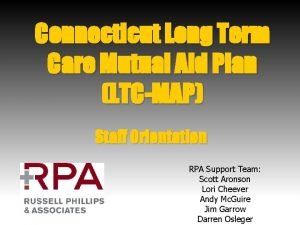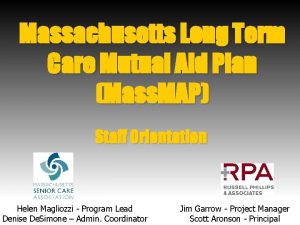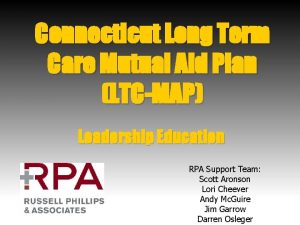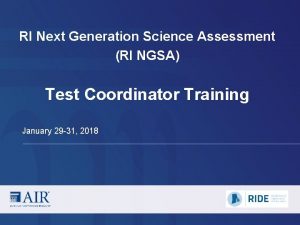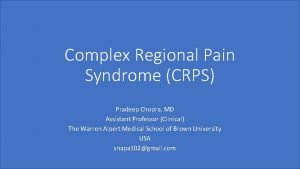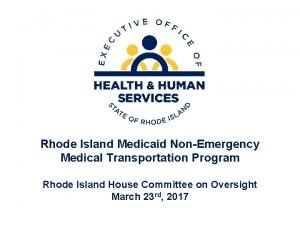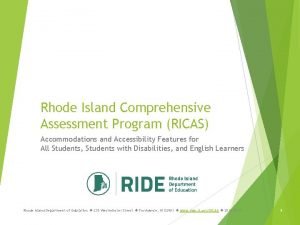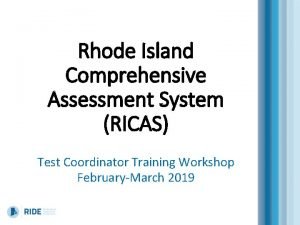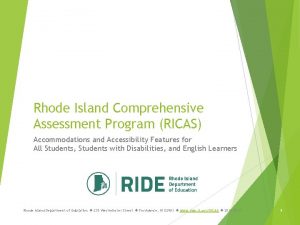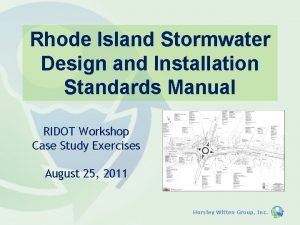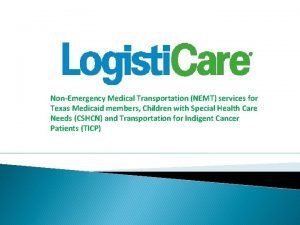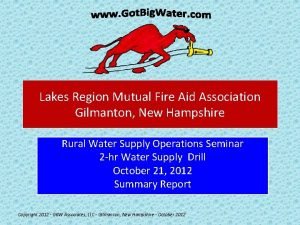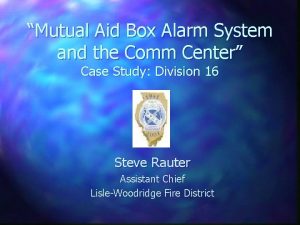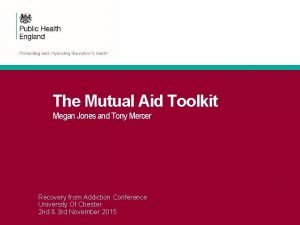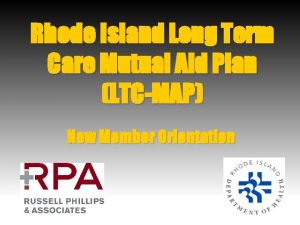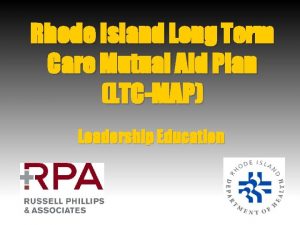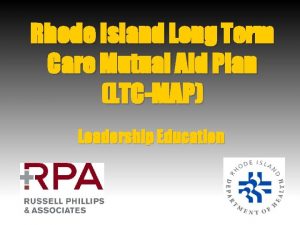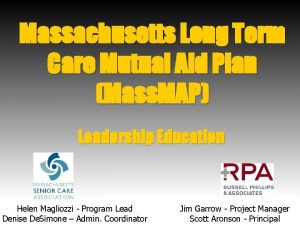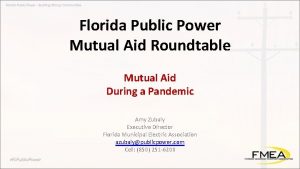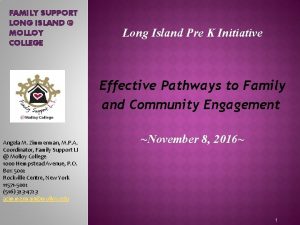Rhode Island Long Term Care Mutual Aid Plan
























- Slides: 24

Rhode Island Long Term Care Mutual Aid Plan (LTC-MAP) Staff Orientation

What Led to Mutual Aid in New England: Learning from experiences in: • • • NY State – 1 st Plan (began in 1983) 2001 Tropical Storm Alison (Houston) 2001 9/11 2005 Hurricanes Katrina / Rita Massachusetts Disasters (1 st New England State) • • May 2006 Flooding (Mother’s Day Storm) November 2006 Chemical Explosion (Danvers) 2008 Ice Storm in Central & Western MA

Mary Immaculate Evacuated (250 beds) (Evacuation: May 2006 / Recovery: Sept. 2006) Source: Boston Globe. com

Other Incidents where Mutual Aid Plans were Activated § § § Aug/Sept 2011 - Tropical Storm Irene/Lee Flooding Oct/Nov 2011 - “Halloween Storm” - Snowstorm/ Power Failure Oct/Nov 2012 - Superstorm Sandy Jan 2013 Influenza Event – Boston & Hartford, CT Activations for Hospital Resident Decompression Feb 2013 – Blizzard (NEMO) Jan 2014 – Snowstorm

OVERVIEW of the RI LTC-MAP

Plan Operation is 1 st within your town/city. Additional Support will come from your Region then other regions in a widespread disaster. ~500 LTC / 30 Hospitals / 4 LTACs or Rehab Hospitals 213 LTC / 11 Hospitals Regions 1, 3, 4 & 5 151 LTC

Northern & Southern Region

The Basics • • Identify needs and provide supplies/ equipment/pharmaceuticals as necessary Assist with transportation of supplies / staff / equipment / evacuated residents Provide staffing support (whether a facility is evacuating or isolated) Place and support the care of evacuated residents (continuity of care / surge locations)

Disaster Struck Facility

Actions of Disaster Struck Facility • NOTIFY: Call 911 / begin Internal Activation process • ACTIVATE: RIDOH Duty Officer (CEPR) at 401 -2226911 to activate the LTC-MAP and Critical Partners through the alert notification system • ACTIVATE: Emergency Reporting System • www. mutualaidplan. org/ri (Could be done by RIDOH)

Transportation Evacuation Surveys (transportation tab on website) Provides Department of Health, Fire, EMS and Emergency Management with strong knowledge of the resources needed to evacuate our facility (Ambulances, wheelchair vehicles and buses) • • Consider completing with monthly fire drills (each resident care area) On website for an automated tool

Pre-established Evacuation Sites • • Primary sites should be pre-selected using the LTC Patient Care Categories (next slide – from website) Address highest acuity residents first • • Who matches up best with you (memory care) Address their surge numbers next Always assume they have no open beds • How many of your residents can they accept at 110% surge • • Process to communicate with them Know where they are • Know who the point people are and contact information •

13

Resident Tracking – What goes with the Resident • Resident Emergency Evacuation Form • • Current Service Plan • • • 1 per resident - info and acuity / mobility / risks Include MAR/Med List and Meds/Controlled Substances Wristband (name / DOB) Resident, MR, Staff & Equip Tracking Sheet • List of residents; by facility they evacuated to • Transportation vehicle info and time departed • What (and whom) went with them • • Photo, if possible DNR Bracelets / Personal Belongings

Resident Accepting Facilities/Lenders

Actions of Resident Accepting Facilities/Lenders • Prepare to receive residents • • • Open beds vs. Surge Area Complete Emergency Reporting Complete the Influx of Resident Log - residents arrive Confirm with DSF or LTC Group Responders that the residents are received – “CLOSE THE LOOP” Start a new chart for resident Notify RIDOH and your local AHJ about activating a Surge Plan (Influx / Surge Guidelines) If Lender: Prepare to provide Resources/Assets

What happens at 2: 00 AM? Anyone who might answer the phone: Basic knowledge that RI LTC-MAP exists (there is a plan) • Get the name of the person calling, facility, contact number and issue or request • OR – Listen to the automated message and take down directions for what it tells you to do • Inform the Nursing Supervisor or Person-in-Charge ASAP • Person-in-Charge – Scope will determine actions • • • Immediate analysis - how many residents can you take Activate internal emergency notification tree Complete Emergency Reporting- www. mutualaidplan. org/ri Evacuation? Prepare to receiving incoming residents Resource & Asset Request: Prepare to provide staff, equipment, supplies or transportation

RI LTC-MAP Website (all tabs are specific to our facility based on data we enter)


Emergency Reporting Designated Facility Leadership or Nursing Supervisor (complete for LTC -MAP when requested)

Internal Situation-Status Report & Emergency Reporting: What You Should Know (and WHY) HANDOUT Operational Issues at your facility (other plan members) • Open Beds • Available Transportation for • • Resident Transportation • Movement of Supplies and Equipment Resources & Assets (needed) • Resources & Assets (you could provide) • • Equipment • Supplies • Staffing

RIDOH Department Operations Center (LTC Group Responders)

Function of the LTC Group Responders “Air Traffic Control” • • • Staffed by RIDOH & volunteers from the LTC-MAP Assist with resident placement Support resident tracking - “Close the loop” Assist with obtaining staff, supplies and equipment Assist with transportation of residents, staff, supplies and equipment Support interaction with local and state agencies ENSURE ALL MEMBERS ARE ACCOUNTED FOR

Who to go to with Questions? Department of Health Center for Emergency Preparedness & Response Alysia Mihalakos Joseph Reppucci Alysia. mihalakos@health. ri. gov joseph. reppucci@health. ri. gov 401 -222 -8035 401 -222 -4787 Russell Phillips & Associates Jim Garrow Scott Aronson jgarrow@phillipsllc. com saronson@phillipsllc. com 860 -793 -8600 Lori Cheever Darren Osleger lcheever@phillipsllc. com dosleger@phillipsllc. com David Hood Scott Aronson dhood@phillipsllc. com saronson@phillipsllc. com 860 -793 -8600
 Ct mutual aid plan
Ct mutual aid plan Long term plan and short term plan
Long term plan and short term plan Massmap mutual aid
Massmap mutual aid Ltcmap
Ltcmap Rhode island small business development center
Rhode island small business development center Ngss assessment portal
Ngss assessment portal Rhode island board of governors for higher education
Rhode island board of governors for higher education Interesting facts rhode island
Interesting facts rhode island Dr chopra rhode island
Dr chopra rhode island Galinha rhode island red
Galinha rhode island red Ri eohhs transportation
Ri eohhs transportation Rhode island
Rhode island Rhode island environmental police
Rhode island environmental police Ricas graphic organizer
Ricas graphic organizer Stem cell treatment rhode island
Stem cell treatment rhode island Ricas math reference sheet
Ricas math reference sheet Rhode island comprehensive assessments system
Rhode island comprehensive assessments system Rhode island comprehensive assessments system
Rhode island comprehensive assessments system Rhode island stormwater manual
Rhode island stormwater manual Logisticare transportation texas
Logisticare transportation texas Lakes region mutual fire aid
Lakes region mutual fire aid Task group social work
Task group social work Mutual aid box alarm system
Mutual aid box alarm system Megan jones bi
Megan jones bi Long term memory vs short term memory
Long term memory vs short term memory
